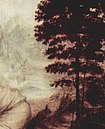Sfumato

Sfumato ( German smoky , blurred ) describes a technique in oil painting that does not depict contours with sharp graphic outlines, but rather blurs them softly with purely painterly means. Backgrounds such as landscapes can also appear to be wrapped in a misty haze and to surround everything with softness. Leonardo da Vinci (1452–1519), who coined the term sfumato and used it especially in his later work, is considered to be the inventor .
technology
Leonardo achieved the impression of a veiled atmosphere by laying thin layers of glaze mixed with white over the painting surface , which was mostly done in dark ocher , thereby creating a shimmering, broken shade of color. With the finest brushstrokes, he distributed the paint application in such a way that the outlines of the motifs seem to flow into one another. The corresponding phenomenon, visible in nature, is part of the aerial perspective : Things that are far away usually appear more indistinct, paler and brighter - except when visibility is good (!).
use
Sfumato was not used by every artist and not all in the same way. However, it belongs to the style - sometimes only to a style phase - of some outstanding painters who had a preference for lyrical, poetic, idyllic moods. It was very popular with pictures of the Madonna or depictions of the holy family or angels in order to create an atmosphere of loveliness and ideal beauty. Occasionally for mysterious effects, such as Leonardo's Salvator Mundi or the Mona Lisa .
Some of the most important artists, apart from Leonardo, are known for their extensive use of sfumato: Giorgione (1478–1510), Andrea del Sarto (1486–1530), Antonio da Correggio (1489–1534), Federigo Barocci (1535– 1612) and some of Leonardo's pupils, especially Bernardino Luini (around 1480–1531). It was later also used by Murillo (1617–1682) and Watteau (1684–1721).
- Sfumato in paintings by famous artists
Andrea del Sarto : Madonna and Child, the Johannesknaben, Elisabeth and an angel , Alte Pinakothek , Munich
Antonio da Correggio : Venus and Cupid with a satyr , 1524–25, Louvre , Paris
Federico Barocci : Madonna and the Cat , ca.1575, National Gallery , London
Bartolomé E. Murillo : La Inmaculada de Soult , 1678, Prado, Madrid
Antoine Watteau : Pilgrimage to Kythera , 1717, Louvre, Paris
Sfumato in contemporary art
Arik Brauer's art provides similar examples in modern painting; where Brauer does not draw the contours of the landscape in the background, but mainly the figures in the foreground. In artistic photography , David Hamilton , among others, made use of this stylistic device, which he created by reducing the depth of field and applied it to the entire image surface of his erotic photographs.
Individual evidence
- ^ The large art dictionary by PW Hartmann, online , accessed on March 13, 2013
- ↑ Ernst Ullmann: Leonardo da Vinci. EASeemann, Leipzig 1998
Web links
- Mona Lisa's secret in farbimpulse.de on May 14, 2008







